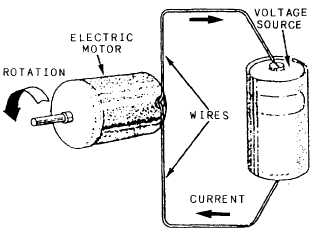Figure 2-1 shows one hydrogen and one
helium atom. Each has a relatively simple
structure. The hydrogen atom has only one
proton in the nucleus with one electron rotating
about it. The helium atom is a little more
complex. It has a nucleus made up of two
protons and two neutrons, with two electrons
rotating about the nucleus. Elements are classified
numerically according to the complexity of their
atoms. The atomic number of an atom is
determined by the number of protons in its
nucleus.
In a neutral state, an atom contains an equal
number of protons and electrons. Therefore, an
atom of hydrogen, which contains one proton and
one electron, has an atomic number of 1; and
helium, with two protons and two electrons, has
an atomic number of 2. The complexity of atomic
structure increases with the number of protons
and electrons.
MAGNETISM
To understand properly the principles of how
electrical equipment produces work, you must
understand magnetism, the effects of magnetism
on electrical equipment, and the relationship of
the different properties of electricity. Magnetism
and electricity are so closely related that the study
of either subject would be incomplete without at
least a basic knowledge of the other.
Much of today’s electrical and electronic
equipment could not function without magnetism.
Computers, tape recorders, and video reproduction
equipment use magnetic tape. High fidelity
speakers use magnets to convert amplifier outputs
into audible sound. Electric motors use magnets
to convert mechanical motion into electrical
energy. Magnetism is generally defined as that
property of a material that enables it to attract
pieces of iron. Material with this property is
known as MAGNETIC. The word magnetic
originated from the ancient Greeks, who found
stones possessing this characteristic. Materials that
are attracted by a magnet, such as iron, steel,
nickel, and cobalt, have the ability to become
magnetized. Thus they are magnetic materials.
Materials, such as paper, wood, glass, or
tin, which are not attracted by magnets, are
considered nonmagnetic. Nonmagnetic materials
Figure 2-2.—The effect of current.
are not able to become magnetized. You will find
additional information on the basic principles of
magnetism in the Navy Electricity and Electronics
Training Series (NEETS), module 1, NAVED-
TRA 172-01-00-88, chapter 1.
ELECTRICITY
Electricity is a combination of a force called
VOLTAGE and the movement of invisible
particles known as CURRENT. The force of
voltage can be compared to the force generated
by a water pump, which moves water through a
distribution system, generally an arrangement of
pipes. Voltage is the force that causes current to
flow through a system of wires. Current is the
movement of invisible particles that causes
electrical devices to operate. We cannot see
current, but we can determine its presence by the
effects it produces. Figure 2-2, for example, shows
the effect of current. It shows how the voltage
force from a battery causes electrical current to
flow through wires and an electrical motor. The
current is invisible, but it produces the effect of
making the motor run. Current flows through the
wires much the same way as water flows through
pipes.
Current consists of electrons, which are
invisible atomic particles. Voltage is the force that
causes current, in the form of electrons, to move
through wires and electrical devices. However, one
important difference between current in wires and
water in pipes is that water can flow out of a
2-3


